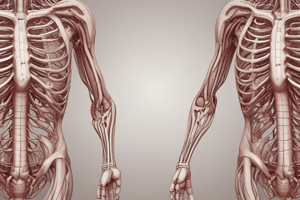Podcast
Questions and Answers
Which artery emerges from the left ventricle of the heart?
Which artery emerges from the left ventricle of the heart?
- Pulmonary artery
- Aorta (correct)
- Subclavian artery
- Brachiocephalic trunk
What is the correct order of major arteries given off by the aortic arch?
What is the correct order of major arteries given off by the aortic arch?
- Brachiocephalic trunk, left subclavian artery, left common carotid artery
- Brachiocephalic trunk, left common carotid artery, left subclavian artery (correct)
- Left common carotid artery, brachiocephalic trunk, left subclavian artery
- Left subclavian artery, left common carotid artery, brachiocephalic trunk
What do the common carotid arteries divide into?
What do the common carotid arteries divide into?
- Ulnar artery and external carotid artery
- Brachial artery and internal carotid artery
- Internal carotid artery and radial artery
- Internal carotid artery and external carotid artery (correct)
Where does the aorta bifurcate into the common iliac arteries?
Where does the aorta bifurcate into the common iliac arteries?
Which artery supplies the organs in the pelvis?
Which artery supplies the organs in the pelvis?
What forms the superior vena cava?
What forms the superior vena cava?
Which artery gives rise to the ulnar and radial arteries?
Which artery gives rise to the ulnar and radial arteries?
Which vein drains venous blood from the lower extremities?
Which vein drains venous blood from the lower extremities?
Flashcards
Aorta
Aorta
The largest artery in the body, originating from the left ventricle and carrying oxygenated blood to all parts of the body.
Parts of the Aorta
Parts of the Aorta
The ascending aorta, aortic arch, and descending aorta. The descending aorta further divides into the thoracic aorta and abdominal aorta.
Subclavian Artery
Subclavian Artery
The artery that supplies blood to the upper extremities and continues as the axillary and brachial arteries.
Common Carotid Arteries
Common Carotid Arteries
Signup and view all the flashcards
Bifurcatio Aorta
Bifurcatio Aorta
Signup and view all the flashcards
Internal Iliac Artery
Internal Iliac Artery
Signup and view all the flashcards
Superior Vena Cava
Superior Vena Cava
Signup and view all the flashcards
Inferior Vena Cava
Inferior Vena Cava
Signup and view all the flashcards
Study Notes
Circulatory System II
- Venules have the lowest pressure.
- The aorta emerges from the left ventricle.
- It initially moves upwards, then curves downwards, and further downwards.
- Parts of the aorta are named ascending aorta, aortic arch, and descending aorta.
- The descending aorta divides into thoracic and abdominal aorta, based on location.
Great Vessels
- The aorta is closest to the heart.
- All systemic arteries are direct or indirect branches of the aorta.
- The aorta is the largest artery.
- It originates from the left ventricle.
- It ascends slightly, then curves downwards.
- Branches of the aorta are named based on their position, such as ascending aorta, aortic arch, and descending aorta.
- Descending aorta branches into thoracic and abdominal aorta, determined by location.
Aortic Arch
- The aortic arch curves like an inverted U, superior to the heart.
- It branches into three major arteries: the brachiocephalic trunk, left common carotid artery, and left subclavian artery.
Coronary Arteries
- Coronary arteries originate from the beginning of the aorta.
- They supply blood to the heart.
Arteries of the Upper Limb
- The subclavian artery is the artery for the upper extremity/
- It continues as the axillary artery.
- Then, it is the brachial artery.
- The brachial artery gives rise to ulnar and radial arteries.
Measuring Pulse
- Pulse is measured at the radial artery.
Common Carotid Artery
- The common carotid artery branches into internal and external carotid arteries.
- The internal carotid artery enters the skull and supplies the brain.
- The external carotid artery supplies the head and neck, excluding the brain.
- The external carotid artery and internal carotid artery are attached via foramina.
Aorta Termination
- The aorta terminates at the level of the 4th lumbar vertebra.
- It bifurcates (divides) into two terminal branches, the right and left common iliac arteries.
Termination of the Aorta
- The right and left common iliac arteries proceed to give rise to internal and external iliac arteries.
- The internal iliac arteries supply the pelvic organs.
- The external iliac arteries continue in the lower limb as the femoral arteries.
Femoral Artery
- The femoral artery travels down the lower limb.
- It becomes the popliteal artery after passing the knee.
Popliteal Artery
- The popliteal artery branches into anterior and posterior tibial arteries.
Veins of the Upper Limb
- Superficial veins are close to the surface, whereas deep veins are close to bones.
- The superficial and deep veins share the same names as the corresponding arteries.
- The basilic and cephalic veins unite at the elbow to form the median cubital vein.
Veins of the Lower Limb
- The superficial veins include the great saphenous vein, which travels from the foot to the groin, and the small saphenous vein, which travels from the foot to the popliteal region.
- The femoral vein is formed from the merging of smaller veins.
Deep Veins of the Lower Limb
- The deep veins include the anterior and posterior tibial veins and the fibular veins, which merge into the popliteal vein, then the femoral vein.
Intravenous Injection
- Intravenous injection involves inserting a needle into a vein.
- Appropriate anatomical regions are utilized for insertion, taking care to consider factors such as needle angle, site, and depth.
Studying That Suits You
Use AI to generate personalized quizzes and flashcards to suit your learning preferences.


